In today’s world, a lot of us spend hours staring down at phones, tablets, or laptops. It might not seem like a big deal, but that forward-tilted head posture adds a surprising amount of stress on your neck and shoulders.
Over time, it builds into what’s commonly called “tech neck.” Tight shoulders, headaches, a stiff upper back, sound familiar? You’re not alone.
The good news: you don’t need a 90-minute yoga class or a gym membership to get relief. A few simple poses, done consistently, can make a huge difference. This five-minute stretch series is designed specifically for people dealing with tech neck.
Just five poses that target the exact spots that hurt and help you reset your posture. Let’s dig into how tech neck works, why yoga helps, and how to make these stretches part of your daily rhythm.
Tech Neck and Why It Hurts So Much
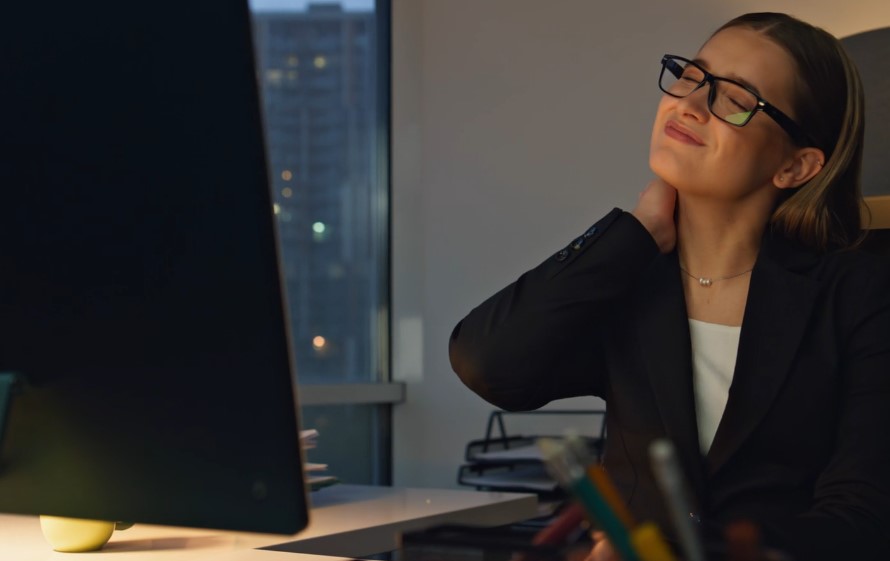
When your head tilts forward, even just 15 degrees, the strain on your neck muscles multiplies fast. A neutral head weighs around 10 to 12 pounds, but at 15 degrees forward, the effective pressure jumps to 27 pounds.
At 30 degrees, it’s around 40 pounds. And if you’re craning your neck at 60 degrees while texting? That’s like hanging a 60-pound weight from your spine. Over time, the result is more than just discomfort:
- Chronic tension in the shoulders and upper back
- Reduced neck mobility
- Headaches that creep up from your shoulders
- Tingling or numbness from compressed nerves
- Long-term posture issues like forward head position or spinal misalignment
And yet, most of us don’t even realize it’s happening until it starts to hurt.
The 5-Minute Tech Neck Yoga Stretch Series
You don’t need a mat or much space. Each of the five poses below targets the most common tension points linked to tech neck.
1. Standing Forward Bend (Uttanasana)
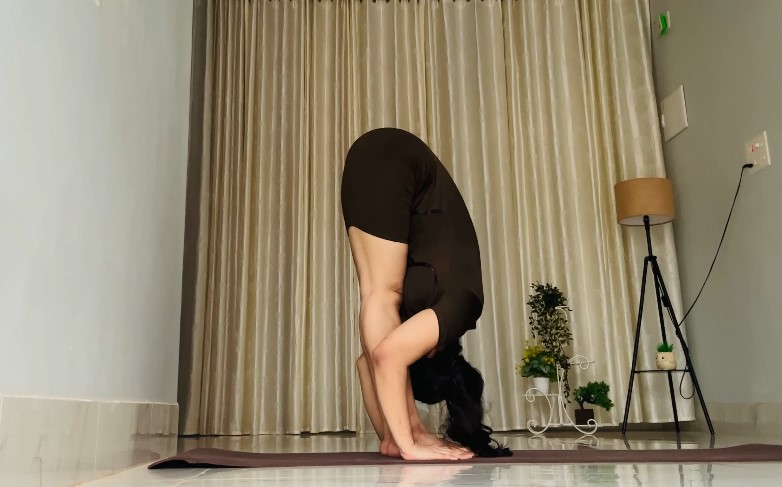
- Start with your feet hip-width apart.
- Hinge at the hips and fold forward, letting your head and arms hang.
- Bend your knees slightly if needed.
- Reach for your legs, the floor, or clasp behind your calves.
- Let gravity gently decompress your neck.
What It Helps With
- Decompresses the cervical spine
- Stretches the back of the neck, spine, hamstrings, and calves
- Calms your nervous system
- May help relieve tension headaches
Tip: If you feel tension in your lower back, bend your knees a little more. Don’t try to force your head lower, just let it hang.
2. Warrior II (Virabhadrasana II)
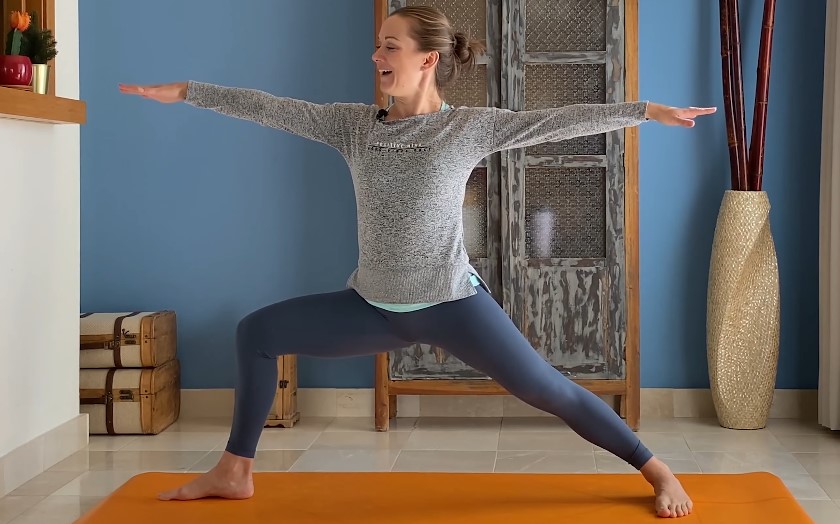
- Step your feet about 3-4 feet apart.
- Turn one foot out 90 degrees and the other slightly inward.
- Bend the front knee so it stacks above the ankle.
- Extend your arms out at shoulder height, palms down.
- Gaze over your front fingers.
What It Helps With
- Opens your chest and shoulders
- Strengthens your legs and core
- Encourages upright posture
- Reduces shoulder and neck tension over time
3. Extended Triangle Pose (Utthita Trikonasana)
- From Warrior II, straighten your front leg.
- Reach forward and tilt down, resting your hand on your shin, ankle, or a block.
- Extend your other arm straight up toward the ceiling.
- Look up gently or keep your gaze neutral.
What It Helps With
- Stretches the side body and spine
- Releases tightness in the upper back
- Improves flexibility and balance
- Targets the trapezius and oblique muscles
Tip: If your neck doesn’t like looking up, don’t force it. Keep your head in a neutral position or gaze downward.
4. Cat-Cow (Marjaryasana-Bitilasana)
@doyogawithstephanie The Cat and Cow pose, also known as Marjaryasana and Bitilasana in yoga, is a simple, yet effective, sequence of poses that can help to improve flexibility, mobility, and posture. Some potential benefits for working professionals include: Improved posture: The Cat and Cow pose can help to improve posture by strengthening the muscles of the back, shoulders, and core, which can help to align the spine and promote better alignment. Increased flexibility: The Cat and Cow pose can help to increase the flexibility of the spine and hips, which can help to reduce tension and stiffness in the muscles and joints. Reduced stress and tension: The Cat and Cow pose can help to release tension and stress from the muscles of the back, shoulders, and neck, which can help to promote a sense of calm and relaxation. Improved digestion: The Cat and Cow pose can stimulate the digestive system and help to improve the digestion process. Improved breathing: The Cat and Cow pose can help to open up the chest and lungs, which can improve breathing and oxygen flow to the body. It is important to note that the Cat and Cow pose is a relatively simple and gentle yoga pose that can be practiced by people of all fitness levels. It’s usually recommended to practice it as a warm-up exercise before doing more demanding yoga poses. It should be done with slow and controlled movements, and always with awareness of the breath. #yoga #catcow #yogatips #fyp
- Start on all fours, with wrists under shoulders and knees under hips.
- Inhale and arch your back, lifting your tailbone and gaze (Cow).
- Exhale and round your spine, tucking your chin (Cat).
- Continue for one full minute, syncing your breath with the movement.
What It Helps With
- Mobilizes the spine gently
- Relieves tension in the neck and between the shoulder blades
- Promotes circulation to tight areas
- Encourages rhythmic breathing, reducing stress
Tip: Move slowly. If your knees are sensitive, use a blanket or pad for cushioning.
5. Thread the Needle (Parsva Balasana)
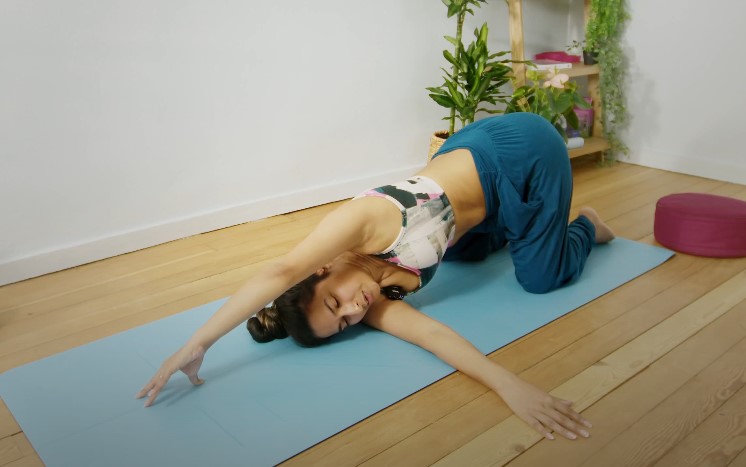
- Start on all fours.
- Slide one arm under your body and rest your shoulder and ear on the floor.
- Stretch the other arm forward or keep it bent for stability.
- Breathe deeply and hold for 30 seconds per side.
What It Helps With
- Releases knots in the upper back and shoulders
- Gently rotates the thoracic spine
- Soothes tension stored in the trapezius and rotator cuff area
Tip: If your shoulder doesn’t quite touch the ground, use a pillow or block for support.
Tips for Making the Most of It
To get the best results and avoid making things worse, keep these pointers in mind:
- Breathe fully: Your breath should be deep and steady. Each inhale can create space, and each exhale can help release tightness.
- Use props: A yoga block, folded blanket, or even a pillow can take pressure off your joints and help you get the stretch without discomfort.
- Move with intention: Avoid jerky or rushed movements. Smooth transitions help you stay in tune with what your body needs.
- Know when to stop: If something feels sharp or painful, back off. Yoga should challenge, not hurt.
Why Yoga Is a Solid Fix for Tech Neck
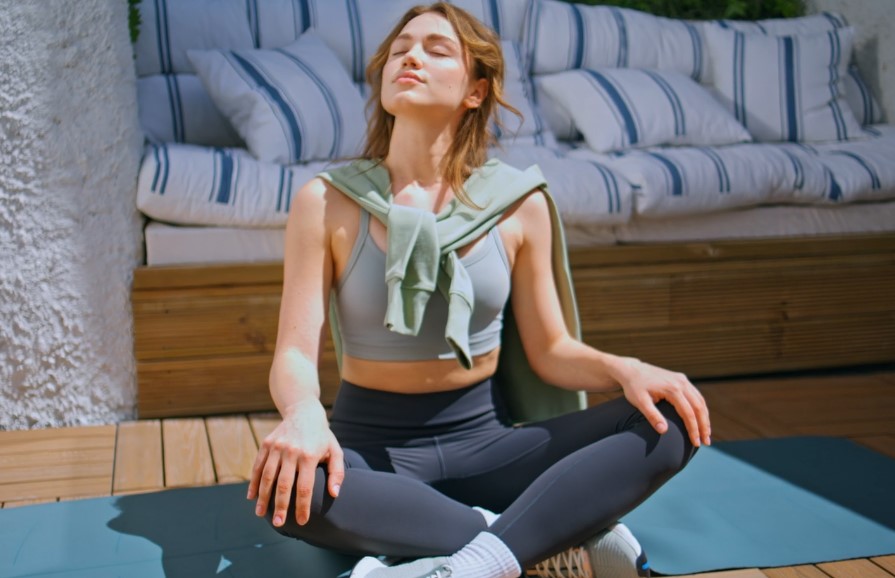
Yoga offers more than just flexibility. For tech neck specifically, here’s where it shines:
- Posture correction: Certain poses reverse that hunched, forward head tilt by strengthening the back and opening the chest.
- Neck and shoulder relief: Stretching key muscle groups like the trapezius and levator scapulae brings direct relief to where the tension lives.
- Better circulation: When you get blood moving through tight muscles, stiffness fades and healing starts.
- Mindfulness: Focusing on breath and body awareness lowers stress, which tends to amplify tension in the upper body.
- Strength building: Engaging your core and upper back during certain poses supports your neck long-term.
According to research, yoga significantly reduced neck pain and improved quality of life.
Another study in the Journal of Rehabilitation Medicine found both yoga and pilates effective for reducing neck-related pain, disability, and even depression.
What Not to Do
Even with a short practice, there are a few common mistakes to avoid:
| Mistake | Why It’s a Problem |
| Forcing a stretch | Can lead to muscle strain or pinched nerves |
| Ignoring neck alignment | May increase pressure on cervical spine |
| Holding breath | Triggers more tension in the body |
| Over-twisting | Especially in Thread the Needle, going too far can cause strain |
| Rushing | You miss the benefits and risk injury |
Prevention
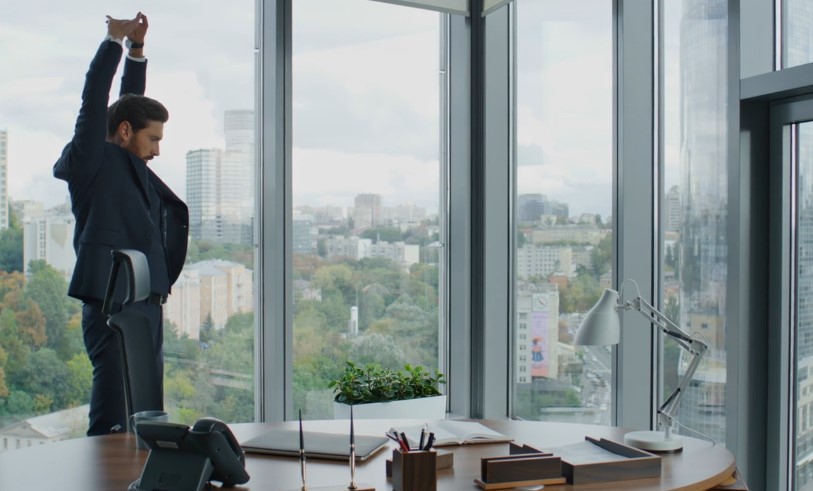
It’s great to stretch when your neck hurts, but you can stay ahead of the pain with small daily habits. Here’s a quick guide:
| Preventive Habit | What to Do | Why It Works |
| Ergonomic Workstation | Keep screens at eye level and use lumbar support | Reduces forward head posture |
| Take Microbreaks | Stretch or walk for a minute every 30 minutes | Breaks the cycle of static posture |
| Raise Your Devices | Use a stand or prop for phones/tablets | Keeps your neck in neutral position |
| Strengthen Posture Muscles | Do rows, shoulder squeezes, or planks regularly | Supports your spine and reduces strain |
| Posture Check | Sit or stand tall, draw shoulders back | Keeps the spine aligned throughout the day |
Wrapping It Up
Five minutes. That’s all it takes to undo a lot of the damage from staring at screens. Each pose in this tech neck series was chosen because it hits the muscles that hurt most: the neck, upper back, shoulders, and spine.
They stretch, they release, and they build long-term support. Add in a few lifestyle tweaks-better posture, screen breaks, ergonomic setups-and you’re setting yourself up for relief that lasts.
No expensive tools, no complicated routines. Just five minutes that could make the difference between a nagging headache and a clear-headed day.
Give your neck what it’s been asking for. Quiet the noise, take the stretch, and reset.

